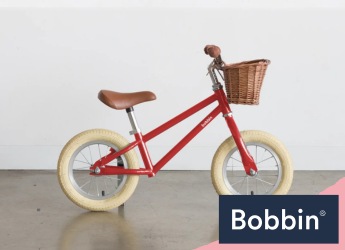What is a Balance Bike?
The best way to introduce children to the world of cycling and then learn fast is to start small. Balance bikes are a great starting point, especially for kids ages 18 months to 2 years old.
By eliminating pedals and training wheels, kids can focus on balance and coordination. This builds confidence and develops essential motor skills. Eventually, this fosters a smooth transition to pedal bikes.
Use this guide to get started! Here, we’ll explain what a balance bike is and how to find the perfect model for your child.
What Is a Balance Bike?
A balance bike is a small, pedal-less bike designed to help children how to balance on two wheels alone. Unlike a traditional bicycle, it lacks pedals, gears, and sometimes even brakes, to add. Instead, it features a low frame, handlebars, and two wheels of equal size.
The purpose of a balance bike is to teach children balance and coordination. This enables them to propel themselves forward off the ground using their feet. Then, they glide along while learning to balance and steer.
What Age Are Balance Bikes For?
(Moonbug Balance Bike)
Balance bikes are designed for children typically between the ages of 18 months and 5 years. This age range can vary per the child’s physical development and coordination. While some may be ready as early as 18 months, others may prefer to start closer to 2 or 3 years old.
Each child develops at their own pace, and it’s important to consider their individual skills. Additionally, factors include their confidence level, height, and leg length. By observing these cues, you can determine the ideal time to introduce a balance bike.
To ensure a proper fit and a safe riding experience, choose a balance bike suitable for your child’s size. Many balance bikes on the market offer adjustable seat heights and handlebars. Features like these can accommodate their changing needs.
Why Choose a Balance Bike?
Balance bikes offer numerous advantages over traditional bicycles with training wheels or stabilisers. Here are some of the key benefits:
Builds confidence
With a balance bike, children learn to balance and steer at their own pace. Not only do they gain confidence, but they also develop the skills needed to ride a two-wheeled bike. This boosted self-assurance extends beyond biking. It can positively impact their overall sense of accomplishment and independence.
Easy to use
Balance bikes are perfect for kids who are still refining their motor skills. They can effortlessly navigate various surfaces, making outdoor exploration a breeze. This seamless experience also encourages a smooth and enjoyable ride.
Safety
With no pedals, balance bikes enable children to easily place their feet on the ground. This grants them greater control and the ability to stop safely whenever needed.
The ability to quickly plant their feet also instils a sense of security. This enables young riders to focus solely on mastering balance and coordination.
Long-lasting
Many balance bikes feature adjustable components, allowing for extended use over several years. They’re built to withstand the rigours of childhood, ensuring durability and longevity.
With adjustable seat heights and handlebars, these bikes can be easily customised too! This adaptability ensures the bike comfortably fits as your child grows, making it a wise investment.
Eco-friendly
Balance bikes are an eco-conscious choice as they require no fuel or electricity. By opting for these pedal-free wonders, you contribute to a greener environment. What’s more, it promotes sustainable transportation alternatives for young riders. Pedal towards a brighter, cleaner future together!
How to Choose a Balance Bike?
When choosing a balance bike, there are a few factors to consider:
- Size. Ensure the bike is the perfect fit for your child. They should be able to sit on the saddle with their feet flat on the ground, allowing for easy balance control. Additionally, the handlebars should be comfortably within reach, promoting proper steering.
- Weight. Opt for a lightweight balance bike that your child can handle and manoeuvre with ease. This allows them to maintain control and build confidence during their riding adventures.
- Tires. Choose between air tires, which provide a smoother ride and better traction. Or opt for foam/solid rubber, which requires less maintenance and is puncture-resistant. Consider the riding conditions and surfaces your child will encounter.
- Brakes. Some balance bikes come with hand brakes. This is a valuable feature for more advanced riders preparing for pedal bikes. Alternatively, many rely on foot-powered stopping. This enables children to develop their balance and control naturally.
By considering these factors, you can select the ideal balance bike for your child!
Round-up
Investing in a balance bike is worthwhile and a win-win situation for both the parents and the child! Peace of mind for the moms and dads, thanks to the safe and enjoyable riding method. And the ability to learn at their own pace for the little riders, boosting their confidence.
Are you ready to choose the perfect balance bike? Explore our range of kids’ bikes and helmets to kick start your child’s biking journey. For further guidance, our guide on teaching kids to ride a balance bike can be a great help!












